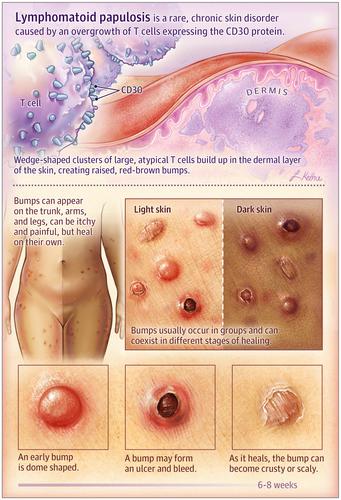JAMA Dermatology ( IF 10.9 ) Pub Date : 2020-01-29 , DOI: 10.1001/jamadermatol.2019.4513 Emma Killoran 1 , Neha Mehta-Shah 2 , Amy Musiek 3

|
Lymphomatoid papulosis is a disorder of the immune system cells that causes red-brown bumps on the skin that come and go. Lymphocytes are a group of cells that fight infection and regulate the immune system. T cells are one group of lymphocytes. Lymphomatoid papulosis occurs when there is an overgrowth of a group of T cells that express a protein called CD30. When those cells collect in the skin, they appear as red-brown bumps or papules. The bumps resolve on their own or self-heal, sometimes with scarring. Lymphomatoid papulosis is rare, affecting 1.5 people in a million. It most commonly occurs in adults in their 40s but can develop in all age groups. This condition does not run in families and is not contagious. Treatment can decrease the frequency of new bumps, but there is no cure.
Lymphomatoid papulosis usually causes small, raised bumps on the skin. They often grow to about the size of a pea and then may form an ulcer and bleed. They typically become crusty or scaly before going away. Without treatment, individual bumps will heal in approximately 6 weeks. While healing, the bumps can be painful or itchy. Lymphomatoid papulosis may come and go for months or many years. Although it is a harmless disease of the skin, patients with this condition are at higher risk for types of cancers called lymphomas. Therefore, it is important for patients to undergo regular follow-up with their primary care physician and dermatologist.
A dermatologist should perform a thorough skin examination and ask questions about any symptoms the patient may be experiencing. A skin biopsy will help confirm the diagnosis and make sure that it is not another condition. It is important to rule out a type of cancer called cutaneous T-cell lymphoma, in which there are abnormal T cells in the skin. Other tests, such as blood work and body scans, may be performed.
中文翻译:

淋巴瘤样丘疹。
淋巴瘤样丘疹病是免疫系统细胞的一种疾病,会引起皮肤上红棕色的肿胀。淋巴细胞是抵抗感染并调节免疫系统的一组细胞。T细胞是一组淋巴细胞。淋巴瘤样丘疹病发生在一组表达CD30蛋白的T细胞过度生长时。当这些细胞聚集在皮肤中时,它们会显示为红褐色的凸起或丘疹。颠簸会自行解决或自我修复,有时会留下疤痕。淋巴瘤样丘疹病很罕见,每百万人中有1.5人受到影响。它最常见于40多岁的成年人,但可以在所有年龄段发展。这种情况不会在家庭中发生,也不会传染。治疗可以减少新的肿块的发生频率,但是无法治愈。
淋巴瘤样丘疹通常会在皮肤上引起小的隆起肿块。它们通常长到豌豆大小,然后可能形成溃疡并出血。它们通常在离开之前变得硬皮或鳞屑。未经治疗,单个肿块将在大约6周内weeks愈。在愈合期间,颠簸可能会很痛或发痒。淋巴瘤样丘疹可能持续数月或数年。尽管这是一种对皮肤无害的疾病,但患有这种疾病的患者罹患称为淋巴瘤的癌症的风险较高。因此,重要的是患者应定期接受其初级保健医生和皮肤科医生的随访。
皮肤科医生应进行彻底的皮肤检查,并询问患者可能遇到的任何症状。皮肤活检将有助于确认诊断,并确保它不是另一种状况。重要的是要排除一种称为皮肤T细胞淋巴瘤的癌症,其中皮肤中存在异常T细胞。可以执行其他检查,例如血液检查和身体扫描。



























 京公网安备 11010802027423号
京公网安备 11010802027423号